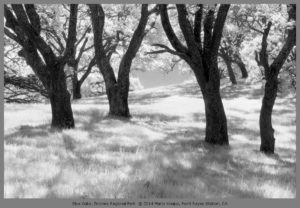An essential creative photography technique is the locating of the perfect place to set your camera when composing an image. My photograph, Blue Oaks, Briones Regional Park, reminds me of just how critical precise camera location is to the making of an expressive image. The right spot is the precise location of the camera in relation to the scene being considered. Adjustments of mere inches can make all the difference. Later in this essay you’ll learn about how I found my spot for the making of the Blue Oaks photograph.
We all have been struck by the beauty of some general scene, one that invites us in to try for an expressive photograph. But too often, we pause, make a quick exposure, and then move on, impatiently, to the next opportunity. I’ve done this – I know we’ve all done this, but creative possibilities will multiply if we just slow down and look deeper. Essential to looking deeper is determining exactly where to position your camera. This is as important as considering the sun angle and quality of the light for your compositions. By the way, I highly recommend working with a tripod when you’re fine-tuning the position of your camera to the scene. It allows you to step away, and look at other positions and angles without losing a “found” location. Take the time to look explore the compositional possibilities – try to find a way that expresses the feeling kindled by that first moment of discovery.
A group of Blue Oaks in Briones Regional Park caught my eye during a springtime walk. I was drawn to the scene and sensed that there was an evocative photograph to make of these backlit trees. I stopped to look more closely. I set my tripod-mounted camera near the trees in a position that was close to my idea for a strong composition. As I looked more closely through my viewfinder, I noticed that the principle subjects, the four trees closest to me, were blocking and or merging with some of the beautiful background trees and foliage. So, I took out my viewing card and walked away from my camera and tripod and began to look for my spot. It’s incredible what happens in a complex scene when you change your position by a few feet, or even inches! As I moved, the foreground trees moved in relation to each other and the background. Shapes blocked and then revealed other shapes. I walked slowly to the left and then to the right, all the while scanning through the card, looking for a potential composition. I alternated my lateral movements with forays toward and away from the trees, pausing every so often to consider the composition. Even the height of my lens affected the view, so I looked from higher and lower positions.
I spent perhaps fifteen minutes looking, as I paced back and forth. Nothing satisfied me. Then, as I was about ready to give up, I found my spot! There was literally only one point in space, to set my lens and get what I had sensed might be there. Literally, just a few inches forward or back, left or right, or up or down, and the composition failed for me. I’m glad I didn’t give up. I continue to use this technique of “finding my spot,” whenever the light and view of a potential composition beckons me on my photo walks.
So, next time you’re out and see a scene that beckons you, I hope you’ll slow down and spend the time it takes to really find your spot. Don’t despair if you don’t eventually find your spot. It could be that there’s nothing there. Even if you decide to make no exposures at all, the exercise of looking for a photograph is well worth the time and will improve your ability to discern and make compelling and evocative compositions in the future. Creative photography done well is an exercise that relies on both inspiration and discernment. Neglect either and the effective expression of your photograph will diminish.
If you enjoyed this essay and would like to be notified by email when I post new essays, please go here to subscribe:
Subscribe via email to Marty Knapp blog

Marty — This is a wonderful image, one that almost shouts “springtime.” Your thoughts on camera placement are spot on. I think you are the first I’ve seen advocating the use of a tripod while searching for the best camera location and I think you are on to a very good idea. Why lose the reference point while seeing if you can improve it? Thanks for this helpful post. Frank
Frank,
Thanks for commenting about the usefulness of a tripod in composing. It’s very easy to become lazy since today’s cameras do one thing well that a tripod originally was formulated for, i.e.. holding the camera steady. However, image stabilization can’t give us the time we need or assist us in the careful consideration of the elements of composition that go into a thoughtfully-produced photograph.
Marty, as usual I enjoyed your post and it was a good reminder that searching for the right location is worth the effort.
Nothing is more important in the quest of a good image than the excellent technique described in your blog.
Great to capture your sweet spot witcha, Marty. One of your best. Cheers!
Probably my biggest challenge; thanks, Marty.